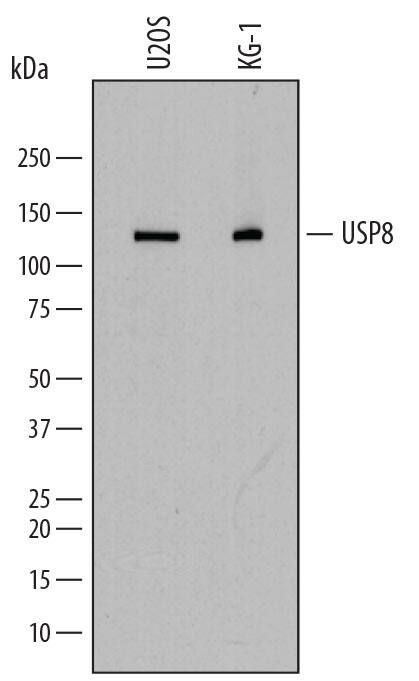USP8 Products
Ubiquitin Specific Peptidase 8 (USP8), also known as Ubiquitin Isopeptidase Y (UBPY), is a widely expressed deubiquitinating enzyme belonging to the peptidase C19 family. It has a predicted molecular weight of 127.5 kDa. Human USP8 is 1118 amino acids (aa) in length and shares 84% aa sequence identity with the mouse and rat orthologs. It contains an N-terminal MIT domain (aa 33-116) that mediates endosomal localization, CHMP-binding, and maintenance of ESCRT-0. USP8 also has a rhodanese domain (aa 181-319) that binds NRDP1 Ubiquitin ligase (E3), a SH3 domain binding sequence (aa 405-413), and a C-terminal catalytic domain (aa 734-1110). USP8 is a growth-regulated enzyme that controls the internalization and endocytic trafficking of cell surface receptors. Some receptors are targeted for internalization and degradation by ubiquitination. USP8 has been shown to disrupt the down-regulation of multiple receptors, including EGF R/ErbB1, ErbB2/Her2, and Smoothened, via their deubiquitination. Conversely, USP8 appears to have the opposite effect on the trafficking of CXCR4, PAR2, and the delta-opioid receptor. Depletion or catalytic inactivation of USP8 stabilized their expression. It is thought that deubiquitination of these receptors down-stream of the sorting endosome commits them to lysosomal degradation. USP8 can be phosphorylated at Ser680 allowing for 14-3-3-epsilon binding, which subsequently inhibits USP8 activity. Additionally, USP8 undergoes tyrosine phosphorylation at its N-terminus following EGF activation of the EGF R/ErbB1 / ErbB2/Her2 receptor complex.
12 results for "USP8" in Products
12 results for "USP8" in Products
USP8 Products
Ubiquitin Specific Peptidase 8 (USP8), also known as Ubiquitin Isopeptidase Y (UBPY), is a widely expressed deubiquitinating enzyme belonging to the peptidase C19 family. It has a predicted molecular weight of 127.5 kDa. Human USP8 is 1118 amino acids (aa) in length and shares 84% aa sequence identity with the mouse and rat orthologs. It contains an N-terminal MIT domain (aa 33-116) that mediates endosomal localization, CHMP-binding, and maintenance of ESCRT-0. USP8 also has a rhodanese domain (aa 181-319) that binds NRDP1 Ubiquitin ligase (E3), a SH3 domain binding sequence (aa 405-413), and a C-terminal catalytic domain (aa 734-1110). USP8 is a growth-regulated enzyme that controls the internalization and endocytic trafficking of cell surface receptors. Some receptors are targeted for internalization and degradation by ubiquitination. USP8 has been shown to disrupt the down-regulation of multiple receptors, including EGF R/ErbB1, ErbB2/Her2, and Smoothened, via their deubiquitination. Conversely, USP8 appears to have the opposite effect on the trafficking of CXCR4, PAR2, and the delta-opioid receptor. Depletion or catalytic inactivation of USP8 stabilized their expression. It is thought that deubiquitination of these receptors down-stream of the sorting endosome commits them to lysosomal degradation. USP8 can be phosphorylated at Ser680 allowing for 14-3-3-epsilon binding, which subsequently inhibits USP8 activity. Additionally, USP8 undergoes tyrosine phosphorylation at its N-terminus following EGF activation of the EGF R/ErbB1 / ErbB2/Her2 receptor complex.
| Reactivity: | Human |
| Details: | Sheep IgG Polyclonal |
| Applications: | WB |
| Source: | Sf 9 (baculovirus) |
| Accession #: | P40818.1 |
| Applications: | EnzAct |
| Reactivity: | Human, Mouse |
| Details: | Rabbit IgG Polyclonal |
| Applications: | IHC, WB, ICC/IF, IP |
| Reactivity: | Human |
| Details: | Rabbit IgG Polyclonal |
| Applications: | IHC, ICC/IF |
| Reactivity: | Human, Mouse, Rat |
| Details: | Rabbit IgG Polyclonal |
| Applications: | WB, ELISA, ICC/IF |
| Reactivity: | Human |
| Details: | Rabbit IgG Polyclonal |
| Applications: | IHC, WB, IP |
| Applications: | AC |
| Applications: | WB |
| Applications: | WB |
| Applications: | WB |
| Applications: | ELISA |
| Applications: | ELISA |




![Western Blot: UBPY/USP8 Antibody [NBP2-20792] Western Blot: UBPY/USP8 Antibody [NBP2-20792]](https://resources.bio-techne.com/images/products/UBPY-USP8-Antibody-Western-Blot-NBP2-20792-img0005.jpg)
![Immunocytochemistry/ Immunofluorescence: UBPY/USP8 Antibody [NBP2-55627] Immunocytochemistry/ Immunofluorescence: UBPY/USP8 Antibody [NBP2-55627]](https://resources.bio-techne.com/images/products/UBPY-USP8-Antibody-Immunocytochemistry-Immunofluorescence-NBP2-55627-img0001.jpg)
![Western Blot: UBPY/USP8 AntibodyAzide and BSA Free [NBP2-94523] Western Blot: UBPY/USP8 AntibodyAzide and BSA Free [NBP2-94523]](https://resources.bio-techne.com/images/products/UBPY-USP8)
![Western Blot: UBPY/USP8 Antibody [NBP1-50001] Western Blot: UBPY/USP8 Antibody [NBP1-50001]](https://resources.bio-techne.com/images/products/UBPY-USP8-Antibody-Western-Blot-NBP1-50001-img0003.jpg)
![Western Blot: UBPY/USP8 Overexpression Lysate [NBP2-11117] Western Blot: UBPY/USP8 Overexpression Lysate [NBP2-11117]](https://resources.bio-techne.com/images/products/UBPY-USP8-Overexpression-Lysate-Adult-Normal-Western-Blot-NBP2-11117-img0001.jpg)
![Western Blot: UBPY/USP8 Overexpression Lysate [NBP2-11118] Western Blot: UBPY/USP8 Overexpression Lysate [NBP2-11118]](https://resources.bio-techne.com/images/products/UBPY-USP8-Overexpression-Lysate-Adult-Normal-Western-Blot-NBP2-11118-img0001.jpg)
![Western Blot: UBPY/USP8 Overexpression Lysate [NBL1-17672] Western Blot: UBPY/USP8 Overexpression Lysate [NBL1-17672]](https://resources.bio-techne.com/images/products/UBPY-USP8-Overexpression-Lysate-Adult-Normal-Western-Blot-NBL1-17672-img0002.jpg)
![ELISA: Human UBPY/USP8 - Ready-To-Use ELISA Kit (Colorimetric) [NBP3-38797] Human UBPY/USP8 - Ready-To-Use ELISA Kit (Colorimetric)](https://resources.bio-techne.com/images/products/nbp3-38797_human-ubpy-usp8-ready-to-use-elisa-kit-colorimetric-211020241538044.png)
![ELISA: Human UBPY/USP8 ELISA Kit (Colorimetric) [NBP3-38798] Human UBPY/USP8 ELISA Kit (Colorimetric)](https://resources.bio-techne.com/images/products/nbp3-38798_human-ubpy-usp8-elisa-kit-colorimetric-2110202415282656.png)